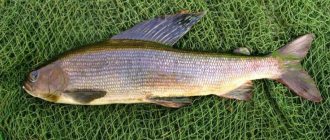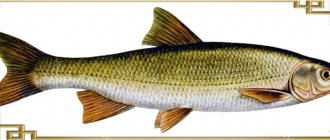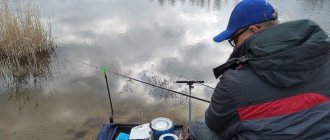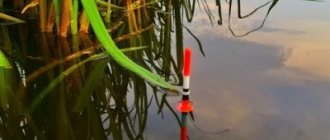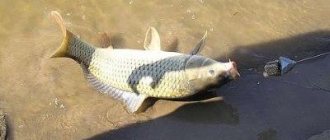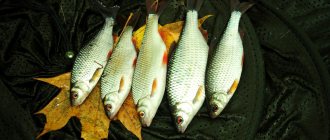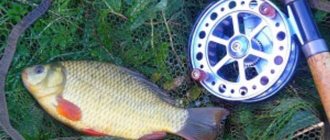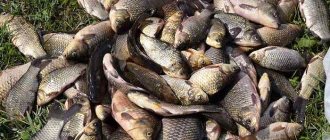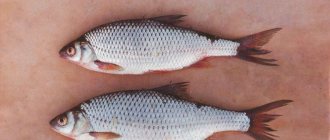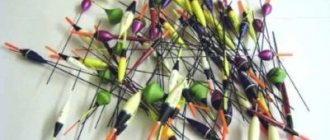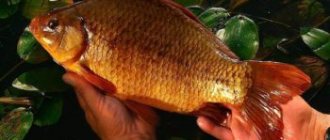Habits of crucian carp in autumn
Crucian carp is a relatively small fish so that the fisherman can boast of a large trophy. Silver (white) crucian carp usually weighs about 1.5 kg, and its maximum weight is 2 kg, for golden (red) this figure is 3 kg. Fish reach it by the 3-4th year of their life. Therefore, the main pleasure of fishing is the excitement and excitement of catching cautious and unpredictable bait.
However, crucian carp is a desirable catch for any fisherman. The trick of the fish is that when it sees the net, it lies to the bottom, and when danger passes by, it emerges and continues its route. Ichthyologists also believe that she not only sees the movement of bait in the water, but accurately identifies it and bites on what interests her at the moment.
Did you know? In November, when the crucian carp is inactive, you can run a long stick along the bottom in the area where the fish are supposed to be, raising the silt. After this, schools of small crucian carp begin to swim to the affected area, interested in possible prey.
This smart fish absolutely accurately notices objects around it, reacting to smells, color combinations, and sounds.
Therefore, she is picky about food and does not always react as the fisherman expects. Crucians tend to play with bait. He can make ten approaches, but still not bite. To catch it you will need to show restraint, ingenuity and fishing skills.
Fish are found in schools, which usually contain individuals of the same age and size. Large flocks form, but disperse and do not take bait if they notice danger.
Fishermen note a good bite in cloudy weather with light warm rain and light wind. The fish are especially active in the quiet autumn drizzle and the first light snow. During this period, she tries to put aside accumulations in the body, which allow her to spend the winter in more comfortable conditions.
Find out also when is the best time to catch crucian carp.
You need to look for crucian carp in calm water, overgrown swampy ponds and small lakes. It can also live in slow-flowing rivers. This member of the carp family is an extremely hardy species that is tolerant of low oxygen levels, allowing it to survive in stagnant and dirty water. But you need to remember that in a frozen reservoir, crucian carp’s metabolism decreases and it stops feeding for several months. It also survives well in dry periods by sinking into the bottom soil.
Where to look for crucian carp in autumn
The body of crucian carp is designed in such a way that it can go without food for a long time both in winter and in summer, when it is hot, as well as during periods of autumn cooling. At this time, the crucian carp does not take bait, so the basis of successful fishing almost always lies in knowledge of the habits and feeding habits of the fish.
Catch crucian carp in places where the main food sources are located. These are shallow backwaters with reed growth and weeds submerged in the water. Float fishing from the shore is considered the most effective way of fishing in such a situation.
Pay attention to the information on how to catch crucian carp in windy weather.
In autumn, water temperatures drop and summer food gradually disappears. Lazy crucian carp swim further and further from the shore, descending to a depth of 3 m - there the temperature is still acceptable for them. If the air warms up again and warm days come, then fish can return to shallow water in the places where they were caught in the summer.
When the reservoir cools down, the crucian carp moves throughout the entire water area until it finds an area with a small layer of silt and a hard bottom. Golden varieties prefer to wait out the cold period, burrowing into the bottom soil layer, while silver varieties find holes in it and prepare for wintering there. Looking for fish in shallow water at this time is a waste of time. In large bodies of water they gather in bottom holes quite far from the shore and practically stop responding to all types of bait. The success of fishing depends on the ability to recognize places where fish accumulate, as well as on fishing skills.
Advantages and disadvantages of fishing in November
The last month of autumn gives anglers a lot of opportunities: November is characterized by special weather conditions that have a positive effect on fishing results. Thus, fishing in November increases the opportunity to become the owner of large prey. This autumn month is suitable for going to the reservoir for perch, burbot, pike perch, bream and pike.
Catching predatory fish brings impressive results, because... predators, in particular pike, feel better in cool water. At the beginning of November, pike, hiding in shelters during the heat, leaves them and shows special activity, so catching them becomes easier.
November fishing is most productive at shallow depths. Often a large number of perch are found in the coastal reeds. In places with a small current, fishing for bream, roach and ide brings good results (but in this case it is recommended to choose deeper places).
Fishermen value the last month of autumn for the opportunity to fish for burbot. When the ice thickens, this fish prefers shallow water (in the vicinity of the shore, burbot preys on invertebrates and small fish).
Another advantage of November fishing is the opportunity to open the jig fishing season. In order to catch with a jig near the shore, it is advisable to choose a hook with a red tip (or painted with reflective paint). Fishing with a jig with a bloodworm attachment is considered effective: this solution ensures the catch of roach and perch. It is recommended to catch perch in the morning and evening hours.
Equipment for fishing with a float rod
There is quite a wide variety of fishing gear. And this equipment may vary depending on the fishing location. Below are the essentials for catching crucian carp.
Important! Carbon rods are much stronger and more sensitive. They are most effective for catching crucian carp.
Rod
For a novice fisherman, a standard float rod, 7 m long, with a telescopic rod is suitable. It should be durable and light. Use it if the weather is warm and the crucian carp are in shallow water.
Take a bottom fishing rod with you if the fish are feeding in the bottom layer due to the cooling of the upper layers of water. The rod can also be telescopic. The equipment of both types of fishing rods is almost the same.
The main types of fishing rods and their features are described in the table.
| Fishing rod type | Key Features |
| Flywheel | A fly fishing rod is considered the most convenient for a novice fisherman. Its advantages:
But this model is inconvenient for fishing in deep layers, since the working distance is limited by the length of the rod, so use a fly rod in shallow waters. |
| Bolognese fishing rod | This is the most common type. It is equipped with guide rings and a spinning reel. With its help, you can cast the bait further and catch crucian carp at depth. But such a product weighs more than a flywheel, and is more difficult to equip. |
| Match fishing rod | Suitable for reservoirs with heavily overgrown bottoms. It can be cast at a distance of up to 60 m, which makes a large area available for searching for fish and allows you to count on a plentiful catch. |
| Picker fishing rod | Suitable for bottom fishing in small, clean reservoirs. This is a lightweight version of a feeder fishing rod. Casting distance - 30 m. |
Float and its loading
For crucian carp you need a sensitive float. The most popular is the “goose feather”. It is quite light and able to respond to even the most careful bite. But if the wind blows, it sways from the movement of the waves, and it is almost impossible to determine whether the fish is biting. Therefore, stick to the classics - these are floats of the “spindle”, “drop”, “reverse drop” type, weighing up to 3 g.
Did you know? Crucian carp
of the golden and silver species are capable of interbreeding, forming hybrid offspring.
At the same time, such fish swim and feed longer than ordinary forms. Some fishermen make their own floats. To do this, they take a goose feather, clean it of fluff, shorten it, paint it in a bright color and put nipples on it, with which it is attached to the fishing line. Do the same with a cocktail tube, only the ends need to be sealed.
2-3 lead pellets are used as a sinker. They are placed next to each other. The distance between the hook and the weight should be about 20 cm. The technique of using it is that if you get a lot of unsuccessful bites, then the distance between the sinker and the hook is increased. And if a crucian carp eats the bait, but this does not affect the float in any way, then, on the contrary, they reduce it.
You might be interested in learning how to stew crucian carp in a frying pan and in a slow cooker.
Hook
For a typical small crucian carp, hooks No. 3–7 are used; for individuals weighing 2-3 kg, hooks No. 5-6 are used.
Basic product characteristics:
- curved forearm - it is necessary for the bait to hang naturally, since there is no prey in the water that is absolutely erect;
- material - steel;
- any color, but not variegated.
You need to set the bait so that the hook is hidden as much as possible. When putting on several layers of bait, there should not be too much of it - cautious crucian carp will not bite on a massive object. The same hook is enough for 2-3 fishing trips, after which it loses its sharpness, so it is not advisable to use it in the future.
You can put on two hooks at once. This is the right decision in cases where you are not sure that the bite will be successful. Then you can use different baits on both hooks, thereby increasing the chance of catching.
Find out also how to deliciously cook crucian carp in the oven.
Coil
A spinning reel or any inertial reel is suitable for a fly fishing rod. For equipment with long casting, only the first one is needed. But, in general, fishing for crucian carp does not have any special requirements for the reel.
Main characteristics of the product:
- width - 2–4 cm;
- spool - metal or graphite;
- number of bearings - 5-6;
- clutch - front.
Important! Using a heavy reel will make the rod heavier and less sensitive.
Line and leash
Monofilament or fluorocarbon fishing line is suitable for crucian carp. The first is made of polymers and has high elasticity and rigidity. The second is also polymer, but more modern. Its peculiarity is that it is almost invisible in the water, but its disadvantage is that it cannot support large fish.
Main parameters of the fishing line:
| Diameter | 0.1–0.14 mm. The thinner the line, the less noticeable it is and the more often the bites. |
| Color | Gray or brown for an overgrown pond, colorless for a clean one. |
Carp can easily bite the fishing line. To prevent this, a leash is placed between the hook and the thread. For a float fishing rod, its length should be between 15–30 cm. If we are talking about a feeder, 20–80 cm. The shorter it is, the greater the resistance of the tackle and the higher the likelihood that the fish will not bite.
Fishermen explain the need for a leash by saying that crucian carp can be capricious and not take the bait. But the situation changes when installing a leash. Whether this is true or not, everyone is convinced from their own experience.
Nozzles
Bream is a fish with very wide taste preferences. They catch it both with plant baits and all kinds of bait.
Vegetable origin
- Dough - prepared from loaf crumb, flour and eggs.
- Mastyrka is a porridge made from boiled peas and semolina; This attachment is universal not only for bream but also for all carp fish in freshwater bodies.
- Canned Corn – This attachment is easily available at any grocery store. It stays very firmly on the hook, attracting bream not only with its smell, but also with its golden color.
- Undercooked potatoes - the tubers are boiled to such an extent that they do not fall apart and can be cut into cubes, which are then placed on a hook.
Animal origin
- Worm - used as bait for large dung crawls.
- Bloodworm is the larva of the squeaking mosquito, used when catching bream on a float in early spring. Place bloodworms on small thin hooks, 2-3 pieces each.
- Maggot is the larva of a blowfly; maggots are baited across the body, 3-4 maggots per hook.
- Pearl barley meat is most often used when catching bream on rivers; the softest and most tender part is used in the shell.
Make your own nozzle
In addition to homogeneous baits, bream are often caught using homemade or purchased boilies.
Homemade boilies are prepared using the following technology:
- Grind 100 grams of sunflower seeds in a coffee grinder to a powder.
- Add 30-40 grams of egg powder, 10-15 grams of sugar and wheat flour to the resulting mass.
- Mix the mixture thoroughly.
- Add water to the resulting dry homogeneous powder and knead until it becomes a thick dough.
- Let the dough sit and thicken.
- Roll into balls, boil them in lightly salted water, and dry.
- Place the finished boilies in a plastic bag with sunflower cake and place in the refrigerator for 2-3 days.
The best autumn baits and baits
Crucians can change their taste preferences, so take at least three different bait options with you. Among them there must be various worms. The second required ingredient is corn.
Important! Crucian carp is partial to a fragrant diet. Therefore, when making bait, fishermen add valerian, sunflower oil, hard cheeses, dill, garlic, Corvalol, raspberry extract and even kerosene.
Other suitable options would be:
- dough made from semolina or flour with flavorings (for example, garlic, valerian or cinnamon);
- boiled or steamed wheat, pearl barley;
- boiled peas;
- boilies;
- bloodworm;
- maggots;
- meat.
Among the store-bought baits there are granules and plasticine. The first is flour with flavors and is intended for fishing with a float rod, and the second is made for bottom fishing with a feeder.
